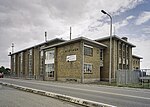Geography of the Netherlands
Geography of the Netherlands

The geography of the European Netherlands is unusual in that much of its land has been reclaimed from the sea and is below sea level, protected by dikes. It is a small country with a total area of 41,545 km2 (16,041 sq mi) and ranked 131st. With a population of 17.4 million and density of 521/km2 (1,350/sq mi) makes it the second most densely populated member of the European Union after Malta, and the 12th most densely populated country in the world, behind only three countries with a population over 16 million. Consequently, the Netherlands is highly urbanized.
Excerpt from the Wikipedia article Geography of the Netherlands (License: CC BY-SA 3.0, Authors, Images).Geography of the Netherlands
Geldersedreef, Lelystad
Geographical coordinates (GPS) Address Nearby Places Show on map
Geographical coordinates (GPS)
| Latitude | Longitude |
|---|---|
| N 52.5 ° | E 5.5 ° |
Address
Geldersedreef
Geldersedreef
8226 RR Lelystad
Flevoland, Netherlands
Open on Google Maps











